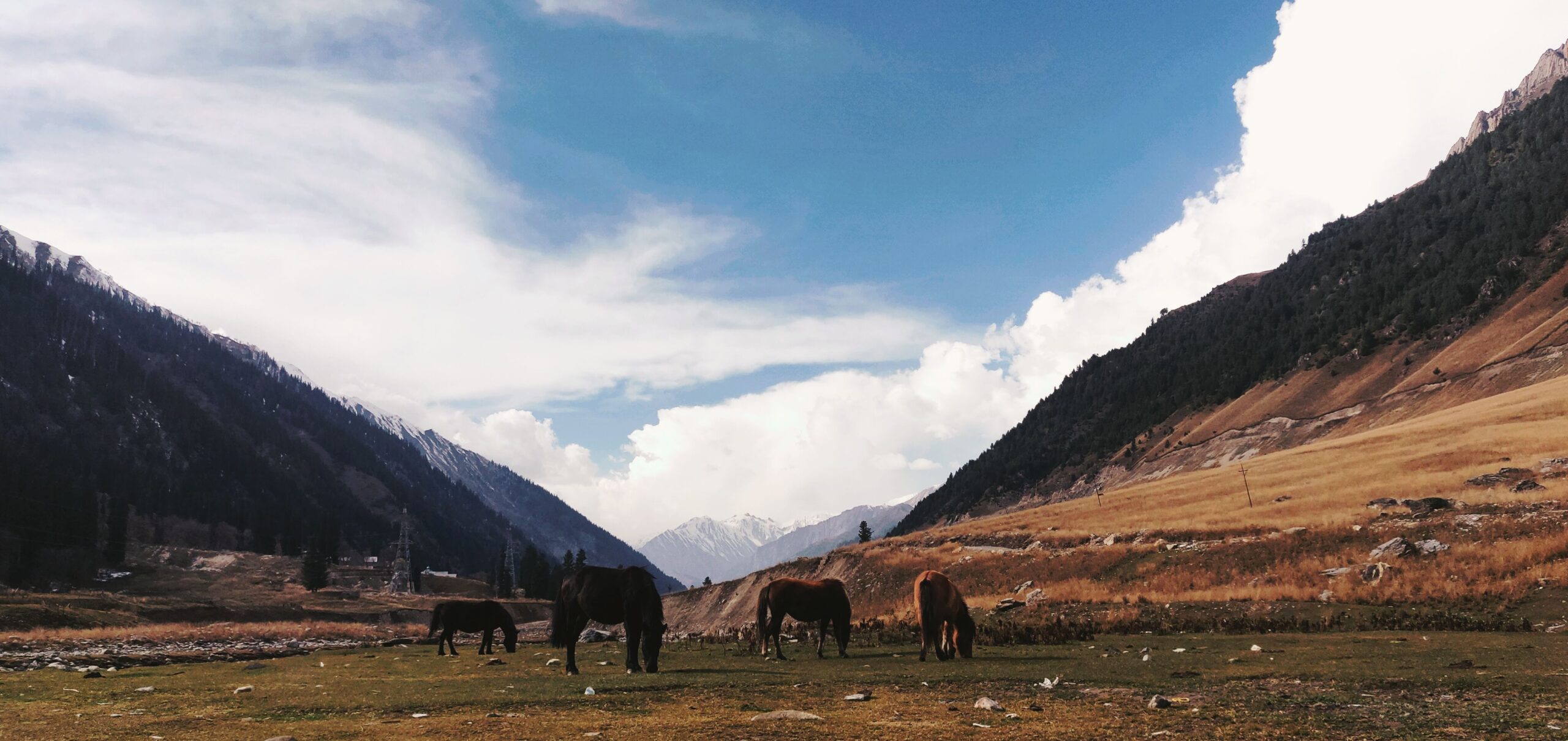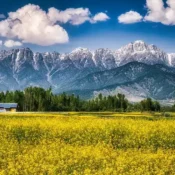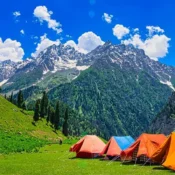
Gulmarg’s Unseen Winter – Future Predictions for Snowfall
Situated in the Pir Panjal Range of the Himalayas, Gulmarg, Kashmir, has long been synonymous with a Winter Wonderland. Revered for its Pristine snow-covered slopes and bustling ski resorts, this idyllic destination has attracted snow enthusiasts from across the globe. However, this year, Gulmarg presents a different picture, one that is starkly unusual and unexpected. The region, known for its scenic winter charm, is currently grappling with a peculiar challenge: an extended dry spell and a conspicuous absence of its trademark snow.
The Current Snowfall Scenario in Gulmarg
As we step into what should have been the peak of Gulmarg’s winter season, the situation on the ground paints a sombre picture. The slopes, usually blanketed in snow and echoing with the sounds of skis and snowboards, are unusually quiet and bare. This anomaly isn’t just a meteorological curiosity, it has profound implications for the local economy, which is heavily reliant on winter tourism.
Local businesses, pivotal to the tourism industry, are feeling the pinch of this unexpected dry spell. Junaid Rafiquee, the owner of the popular Black Bear Brew café in Gulmarg, paints a vivid picture of the situation. “Our café, a hub for pre-ski coffee and camaraderie, would typically open in December and close in March, bustling with visitors. However, this season’s lack of snow has kept our doors closed, and the absence of tourists has been deeply felt,” he shares. Rafiquee’s account is a microcosm of the wider economic impact that Gulmarg is currently experiencing.
Understanding the Dry Spell in Gulmarg
The unusual weather pattern in Gulmarg isn’t an isolated event. The Kashmir Valley, in its entirety, has reported a staggering 79% rainfall deficit throughout December. This significant shortfall in precipitation has directly contributed to the absence of the much-anticipated snowfall in the region.
But what’s behind this dramatic shift in weather patterns? Meteorological experts point towards El Niño, a complex climatic phenomenon characterized by the warming of sea surface temperatures in the central and eastern Pacific Ocean. This warming has far-reaching implications, influencing global weather patterns, including those in Kashmir.
El Niño’s impact on Kashmir is multifaceted. It not only disrupts the usual precipitation levels but also leads to milder winters and reduced snowfall. This year’s dry spell in Gulmarg is a stark reminder of the broader climatic changes affecting our planet. The absence of snow in this winter paradise is more than just a seasonal variance; it’s a signal of the changing rhythms of our climate, a phenomenon that demands our attention and action.
Broader Implications of the Dry Spell in Gulmarg
The unprecedented dry spell in Gulmarg not only alters the landscape but echoes through various sectors, affecting both the environment and the community. A significant concern arises in the realm of local agriculture. For instance, saffron farmers in the region face acute challenges. Saffron cultivation, deeply rooted in Kashmir’s agricultural heritage, relies heavily on specific climatic conditions, which the dry spell disrupts. The lack of adequate moisture and the resultant change in the farming cycle are causing a decline in saffron production, a critical economic and cultural staple.
The environmental impact extends beyond agriculture. The region’s glaciers, an essential source of fresh water, are experiencing shrinkage. This phenomenon is not just a geological concern but also has far-reaching implications for water availability. As glaciers recede, the replenishment of groundwater levels diminishes, thereby affecting the entire ecosystem, including the horticulture sector, which is pivotal to the region’s economy.
The socio-economic fabric of Gulmarg, heavily reliant on winter tourism, is also unravelling. Locals and tourists alike express their disappointment, as the usual winter sports and leisure activities are off the table. A local tourist guide shares, “The charm of Gulmarg lies in its snow-covered slopes. Without it, the essence of our town is lost, and so is our livelihood.” This sentiment is echoed by tourists, who had anticipated a snowy retreat only to find barren landscapes. The cascading effect of this dry spell is palpable, as hotel bookings plummet and the usual hustle of the winter season fades into a quiet lull.
Climate Change and Its Role in The Current Dry Spell
The unusual weather patterns experienced in Gulmarg and the broader Kashmir region cannot be discussed without addressing the elephant in the room ‘climate change’. Experts are increasingly pointing to global warming as a significant factor contributing to these changes. The rising global temperatures, a consequence of increased greenhouse gas emissions, are altering weather patterns worldwide, and Kashmir is no exception.
Deforestation also plays a critical role in this changing climatic scenario. The loss of forest cover in the region disrupts the natural balance, affecting rainfall patterns and leading to temperature variations. Renowned environmentalists highlight the impact of human activities, such as excessive tourism and carbon emissions, on these delicate ecosystems. The deforestation in Kashmir, quantified by the loss of hectares of natural forest, is not just a local issue but a global concern, contributing to increased carbon dioxide emissions and further exacerbating climate change.
The situation in Gulmarg serves as a stark reminder of the broader environmental challenges we face. The changing weather patterns are a wake-up call, urging us to revaluate our relationship with nature. It underscores the need for sustainable practices and effective climate policies to preserve the natural beauty and ecological balance of regions like Kashmir.
Future Predictions of Snow in Gulmarg
As we navigate through this unusual season, the latest snow forecast for Gulmarg provides a glimmer of hope amidst the prevailing dry conditions. According to the recent forecast, moderate snowfall is expected on Monday 29th January, with new snow accumulation ranging from 1cm to 8cm. This anticipated snowfall, stretching from an elevation of 3,115 meters down to the resort level, could momentarily revive the winter spirit of Gulmarg.
The temperature during this time is predicted to fluctuate, with a maximum of 4℃ and a minimum of -1℃. This brief spell of snow could offer some respite to the local businesses and snow enthusiasts, albeit temporarily. However, it’s crucial to note that these predictions are subject to change, especially beyond two days, with variable reliability.
This forecast highlights the potential for snowfall in the near term, but also underscores the unpredictability of current weather patterns. The actual snow depth in Gulmarg, on any given slope, may vary significantly, influenced by factors such as wind conditions and fluctuating temperatures.
Final Note
As we look towards the remainder of the season, it’s important to remain hopeful yet realistic about the prospects of snowfall. While the forecast offers a positive outlook for the coming week, the broader environmental trends remind us of the need for adaptive strategies and sustainable practices in the face of changing climate conditions.
One thought on “Gulmarg’s Unseen Winter – Future Predictions for Snowfall”
Add a Comment Cancel reply
All Categories
Recent Posts
Celebrate Diwali in Kashmir: Light, Snow & Serenity
12 Tourist Destinations in J&K Reopen After Post-Pahalgam Curbs
Kashmir’s Doors Reopen: Paradise Beckons Once More






[…] Also, Read: Gulmarg’s Unseen Winter – Future Predictions for Snowfall […]